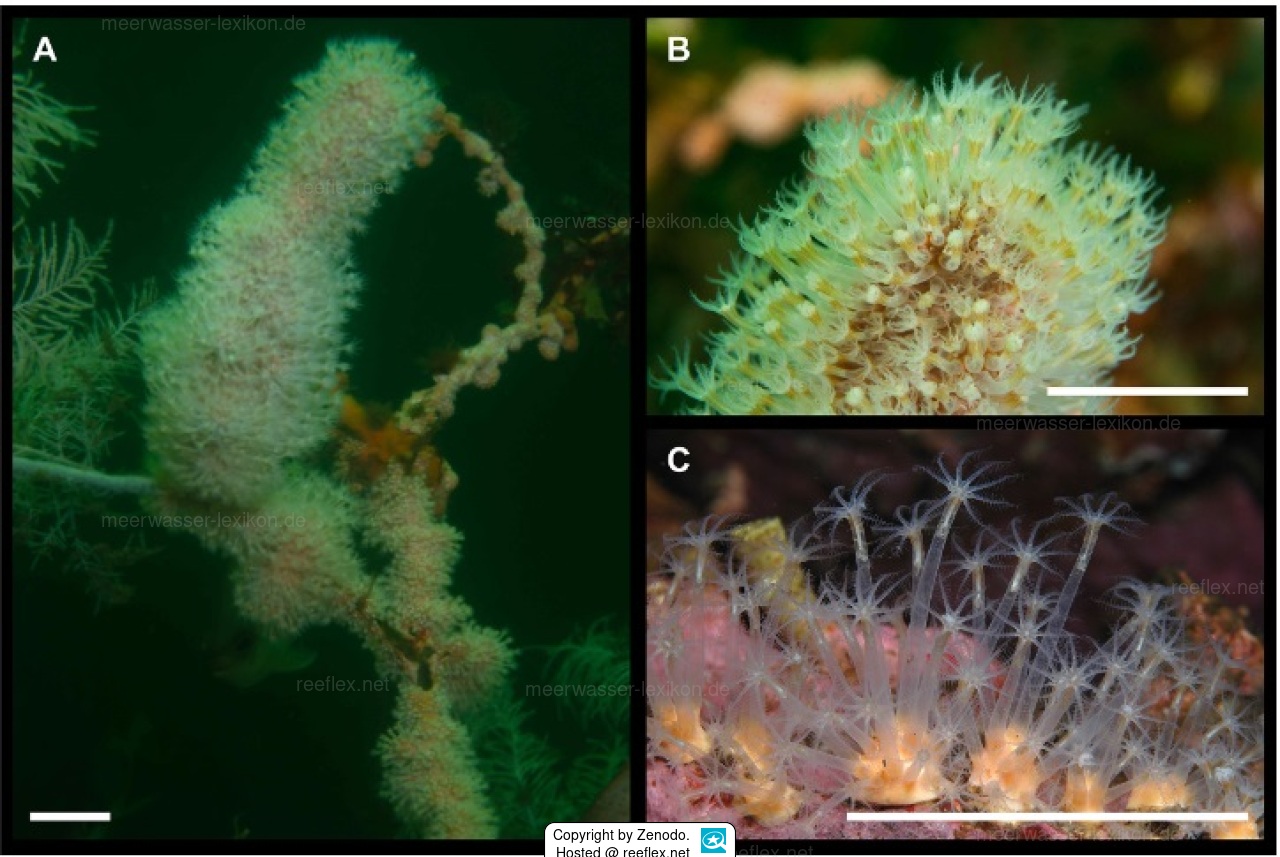Info
Every day new species from the animal and plant kingdoms are discovered and described, often after months of field research.
Thus the idealized, exploratory, yet adventurous approach, but, the majority of species discoveries actually occur in the processing of collected specimens in a museum, according to Dr. Gustav M. Kessel of Victoria University of Wellington, Wellington, Aotearoa-New Zealand.
Dr. Kessel took on this challenge and his work resulted in an initial description of a whopping 10 new species, all previously assigned to Alcyonium aurantiacum.
One of these new species is the soft coral Ushanaia fervens.
The colonies of Ushanaia fervens form branched lobes, the color varies from pale to dark orange, with white polyps.
The tentacles contain irregular, warty, scale-like sclerites. The polyp neck contains spiny spindles and warty, rod-like sclerites.
Polyp mound contain slender, spiny clubs and warty, rod-like and spindle-like sclerites.
Ushanaia fervens is an azooxanthellate soft coral with a predominantly crustose growth form, although fleshy, lobed appendages may also occur. The polyps are fully retractile.
Comparisons: Unlike Kotatea species, Ushanaia species form encrusting colonies.
Etymology
The species name is the Latin "fervens", meaning "red-hot" or "burning", referring to the flame-like red and orange color combination of the specimens examined.
Etymology:
The genus name "Ushanaia" was named after Dr. Kessel's fiancée, Ushana.
Literature finding::
Kessel, Gustav M., Alderslade, Philip, Bilewitch, Jaret P., Schnabel, Kareen E., Norman, Jerry, Potts, Romana Tekaharoa, Gardner, Jonathan P.A. (2022):
Dead man's fingers point to new taxa: two new genera of New Zealand soft corals (Anthozoa, Octocorallia) and a revision of Alcyonium aurantiacum Quoy & Gaimard, 1833
European Journal of Taxonomy 837: 1-85, DOI: doi.org, URL: zoobank.org
creativecommons.org
Thus the idealized, exploratory, yet adventurous approach, but, the majority of species discoveries actually occur in the processing of collected specimens in a museum, according to Dr. Gustav M. Kessel of Victoria University of Wellington, Wellington, Aotearoa-New Zealand.
Dr. Kessel took on this challenge and his work resulted in an initial description of a whopping 10 new species, all previously assigned to Alcyonium aurantiacum.
One of these new species is the soft coral Ushanaia fervens.
The colonies of Ushanaia fervens form branched lobes, the color varies from pale to dark orange, with white polyps.
The tentacles contain irregular, warty, scale-like sclerites. The polyp neck contains spiny spindles and warty, rod-like sclerites.
Polyp mound contain slender, spiny clubs and warty, rod-like and spindle-like sclerites.
Ushanaia fervens is an azooxanthellate soft coral with a predominantly crustose growth form, although fleshy, lobed appendages may also occur. The polyps are fully retractile.
Comparisons: Unlike Kotatea species, Ushanaia species form encrusting colonies.
Etymology
The species name is the Latin "fervens", meaning "red-hot" or "burning", referring to the flame-like red and orange color combination of the specimens examined.
Etymology:
The genus name "Ushanaia" was named after Dr. Kessel's fiancée, Ushana.
Literature finding::
Kessel, Gustav M., Alderslade, Philip, Bilewitch, Jaret P., Schnabel, Kareen E., Norman, Jerry, Potts, Romana Tekaharoa, Gardner, Jonathan P.A. (2022):
Dead man's fingers point to new taxa: two new genera of New Zealand soft corals (Anthozoa, Octocorallia) and a revision of Alcyonium aurantiacum Quoy & Gaimard, 1833
European Journal of Taxonomy 837: 1-85, DOI: doi.org, URL: zoobank.org
creativecommons.org







 Zenodo
Zenodo





